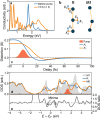Decoupled few-femtosecond phase transitions in vanadium dioxide
- PMID: 40253400
- PMCID: PMC12009403
- DOI: 10.1038/s41467-025-58895-z
Decoupled few-femtosecond phase transitions in vanadium dioxide
Abstract
The nature of the insulator-to-metal phase transition in vanadium dioxide (VO2) is one of the longest-standing problems in condensed-matter physics. Ultrafast spectroscopy has long promised to determine whether the transition is primarily driven by the electronic or structural degree of freedom, but measurements to date have been stymied by their sensitivity to only one of these components and/or their limited temporal resolution. Here we use ultra-broadband few-femtosecond pump-probe spectroscopy to resolve the electronic and structural phase transitions in VO2 at their fundamental time scales. Our experiments show that the system transforms into a bad-metallic phase within 10 fs after photoexcitation, but requires another 100 fs to complete the transition, during which we observe electronic oscillations and a partial re-opening of the bandgap, signalling a transient semi-metallic state. Comparisons with tensor-network simulations and density-functional theory calculations show these features result from an unexpectedly fast structural transition, in which the vanadium dimers separate and untwist with two different timescales. Our results resolve the structural and electronic nature of the light-induced phase transition in VO2 and establish ultra-broadband few-femtosecond spectroscopy as a powerful tool for studying quantum materials out of equilibrium.
© 2025. The Author(s).
Conflict of interest statement
Competing interests: The authors declare no competing interests.
Figures




References
-
- Zylbersztejn, A. & Mott, N. F. Metal-insulator transition in vanadium dioxide. Phys. Rev. B11, 4383–4395 (1975).
-
- Goodenough, J. B. The two components of the crystallographic transition in VO2. J. Solid State Chem.3, 490–500 (1971).
-
- Grandi, F., Amaricci, A. & Fabrizio, M. Unraveling the Mott-Peierls intrigue in vanadium dioxide. Phys. Rev. Res. 2, 013298 (2020).
-
- Allen, P. B. Theory of thermal relaxation of electrons in metals. Phys. Rev. Lett.59, 1460–1463 (1987). - PubMed
-
- Cavalleri, A., Dekorsy, T., Chong, H. H. W., Kieffer, J. C. & Schoenlein, R. W. Evidence for a structurally-driven insulator-to-metal transition in VO2: A view from the ultrafast timescale. Phys. Rev. B70, 161102 (2004).
Grants and funding
LinkOut - more resources
Full Text Sources
Research Materials

